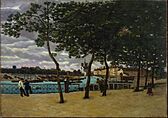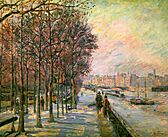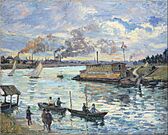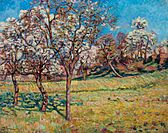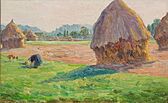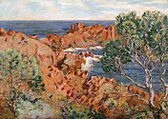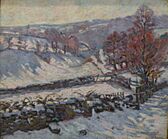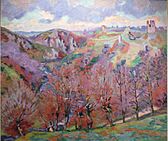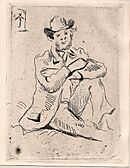Armand Guillaumin facts for kids
Quick facts for kids
Armand Guillaumin
|
|
|---|---|
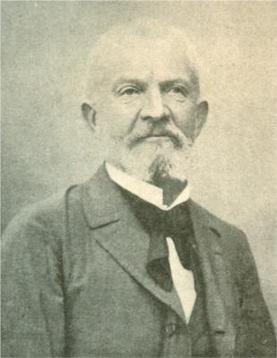 |
|
| Born |
Jean-Baptiste Armand Guillaumin
16 February 1841 Paris, France
|
| Died | 26 June 1927 (aged 86) |
| Nationality | French |
| Known for | Painting |
| Movement | Impressionism |
| Signature | |
 |
|
Armand Guillaumin (French: [ɡijomɛ̃]) was a French painter and lithographer. He was born on February 16, 1841, and passed away on June 26, 1927. Guillaumin was a key artist in the Impressionist art movement. He is especially known for his vibrant and colorful landscape paintings.
Contents
About Armand Guillaumin
His Early Life
Armand Guillaumin was born in Paris, France. His full name was Jean-Baptiste Armand Guillaumin. When he was young, he worked in his uncle's shop. At the same time, he took drawing classes in the evenings. He also worked for a French railway company.
In 1861, he started studying at the Académie Suisse. There, he met two other famous artists: Paul Cézanne and Camille Pissarro. They became lifelong friends. Even though Guillaumin might not be as famous as them, he greatly influenced their art.
In 1863, Guillaumin, Cézanne, and Pissarro showed their art at the Salon des Refusés. This was an exhibition for artists whose work was rejected by the official art show. In the 1870s, these three friends often painted together. For a while, Guillaumin and Cézanne even had studios next to each other in Paris. Cézanne made an etching of Guillaumin in 1873.
Guillaumin was part of a group called the Société anonyme des artistes peintres, sculpteurs et graveurs. This group later became known as the Impressionists. He took part in six of their eight art shows. Critics noticed his strong brushstrokes and bold use of colors. One critic in 1886 called him a "furious colorist." By the 1890s, his paintings became even more colorful. He used bright colors that were not always true to nature. He was painting in a style similar to Fauvism years before that movement began.
Becoming a Full-Time Artist
In 1886, Guillaumin became friends with Vincent van Gogh. Vincent's brother, Theo, helped sell some of Guillaumin's paintings. Vincent van Gogh really admired Guillaumin's work. He wrote about it in many of his letters.
In the mid-1880s, Guillaumin's art studio was a popular meeting spot. Young artists like Paul Gauguin, Paul Signac, and Georges Seurat would gather there. Guillaumin was finally able to quit his government job in 1891. This happened after he won a large amount of money in the state lottery. After that, he could focus on painting all the time.
His Art and Legacy
Armand Guillaumin had many big art shows in Paris. His paintings are known for their bright colors. You can find his artworks in major museums around the world. These include the Musée d'Orsay in Paris and the Tate Britain in London. His art is also in museums in Germany, Russia, and the United States. Many private art collectors also bought his paintings.
Guillaumin is best known for his landscape paintings. He often painted scenes of Paris and the Creuse region of France. He also painted areas near the Mediterranean Sea coast.
Guillaumin was seen as a leader of the École de Crozant. This was a group of painters who focused on painting the landscapes around the village of Crozant. One of his paintings, Landscape in Crozant, is in the Art Institute of Chicago. There is even a statue of him near the church in Crozant.
Later Life and Death
Armand Guillaumin passed away in 1927. He died in Orly, which is just south of Paris.
Gallery
-
View of the Seine, Paris, 1871, Oil on canvas, 126.4 × 181.3 cm., Museum of Fine Arts, Houston
-
Sunset at Ivry (Soleil couchant à Ivry), 1873, 81 cm x 65 cm. Oil on canvas. Musée d'Orsay
-
Les Pommiers à Damiette, 1893, Aberdeen Art Gallery
See Also
 In Spanish: Armand Guillaumin para niños
In Spanish: Armand Guillaumin para niños





